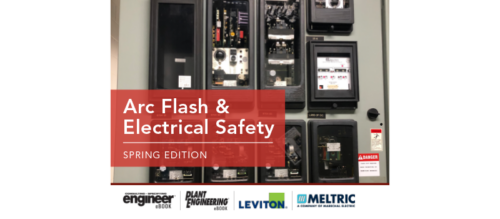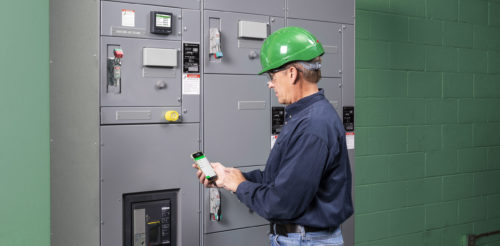NFPA-70E compliance takes more than a label
Since the release of IEEE-1584 in September 2002 and NFPA-70E, 2004 Edition, I have talked with hundreds of facility engineers concerned about NFPA-70E arc-flash hazard compliance. NFPA, the IEEE Safety Committee and other groups have done a great job of spreading the word regarding arc-flash hazards and the need to address this specific safety issue.
Since the release of IEEE-1584 in September 2002 and NFPA-70E, 2004 Edition, I have talked with hundreds of facility engineers concerned about NFPA-70E arc-flash hazard compliance. NFPA, the IEEE Safety Committee and other groups have done a great job of spreading the word regarding arc-flash hazards and the need to address this specific safety issue.
Unfortunately, most engineers I have spoken with are under the misconception that if they label equipment for arc-flash hazards and enforce the use of personal protective equipment per the label, they are in compliance with 70E and OSHA requirements. Nothing could be further from the truth. Arc-flash hazard labeling and PPE compliance are only a small part of 70E compliance and even a smaller part of a properly defined safety program.
Very few facility engineers appear to understand the thought process behind 70E or the basis for the standard. If maintenance people are not informed why they must work within certain safety constraints, then the arc-flash label and PPE requirements become merely another task that can be sidestepped.
Safety as a principle
Gary McGuire, a safety manager for a large pulp and paper mill in the Northwest says, “Safety must be operated by principle, not practice.” He stresses the “why” of safety, not just the dos and don’ts of a task. This knowledge gives people confronted with something out of the ordinary the background to understand the potential dangers, enabling them to make safe choices. Safety is a culture that must be ingrained with principle. This culture starts from management and filters down to the worker where ultimate responsibility rests.
The current arc-flash phenomenon appears to be operating on fear rather than principle. The fear is massive lawsuits and OSHA fines if an accident does occur rather than a sound reasoning as to why a safety culture makes good business sense in daily operations. While it may have taken some fear in the initial movement to motivate companies toward implementing safety standards, if the safety aspect of arcflash is limited to labeling and PPE requirements, the inclination will soon wear off.
Labeling or stating PPE requirements will not prevent accidents. Accidents are prevented and lives are saved through a foundation of safety.
NFPA-70E and the safety culture
Several aspects of 70E in particular make good business sense and help promote a safety culture in your facility:
-
Article 205.2, 120.2(F)(1)(a) Updated and verified one-line diagram — An updated and accurate electrical one-line diagram is an essential ingredient for electrical safety. If workers do not have an accurate map of the system, they can be exposed to potential back feeds from alternate sources, energized capacitors, undocumented switching conditions and unknown voltages, in addition to the problem of not being able to accurately perform lock-out-tag-out procedures. This is one of the most neglected aspects of electrical safety in our industry. Very few of the facilities I have reviewed in the past 20 years maintain accurate electrical one-line diagrams. Accurate one-lines make good business sense because work will get done more quickly, efficiently and safely.
-
Article 400.5, 400.6 Equipment duty verification —Another important aspect is proper application and rating of equipment for the available short circuit duty. One facility I reviewed recently had underrated 13.8 kV breakers in an open switchyard. We informed them of the problem, but management did not take the warning seriously, since it had operated for 20 years without a problem. We were called in approximately a year later to inspect one unit that had exploded into hundreds of pieces of shrapnel-like metal!
-
Almost every facility has improperly applied equipment that will not withstand the available fault current and potentially will not clear an arc hazard. These types of accidents, while not common, are very dangerous. Properly rated and verified equipment makes good business sense. Unplanned outages and disaster recovery costs are expensive, and improperly rated and applied equipment can be considered negligence.
-
Article 110.7 and 130.1—3 Electrical Safety Program, Work Permits — In my opinion, this is the heart of 70E and worker safety. Without safety program principles, procedures, hazard/risk evaluation, work permits and job briefing and planning, safety is relegated to a mere label with a PPE number. Workers are then left to fend for themselves “to get the job done” as many have done for years. When workers do not receive managerial support and are tasked with dangerous job functions, their morale deteriorates and incidents increase. This seems to be an unrecognized cost in today’s business culture.
-
NFPA-70E is a comprehensive document that approaches safety from a system viewpoint, just as system engineers do when analyzing an electrical system. While I do not agree with everything in 70E, I do believe the standard is well laid out and provides sufficient flexibility to allow tailoring a safety program to the individual facility. This is an important step in developing a “safety culture” for your facility.
As the word continues to spread regarding 70E, we hope more companies will begin to understand that labels and PPE do not fulfill the requirements for 70E compliance. Worker safety can only be implemented through principles and culture, which will in the long-term pay benefits to the bottom line.
Author Information Chet Davis, P.E., is the President of ESA, Inc., Clackamas, OR, and the chief designer of the Easy-Power software suite for the analysis of arc-flash hazards for industrial power systems. Mr. Davis has been actively involved in analyzing and troubleshooting industrial power systems for 24 years. He received his BSEE from Oregon State University in 1981 and is a member of IEEE-1584 (Arc-Flash Standard) and various other IEEE committees related to analyzing electrical power systems. Mr. Davis can be reached by contacting chet@easypower.com . Guidance on arc flash
There are four main standards regarding arc flash. They include:
The National Fire Protection Association NFPA 70E discusses how to implement worker safeguards when working on or near exposed electrical conductors or circuit parts that could become energized
OSHA Standards 29-CFR, Part 1910 . Occupational Safety and Health Standards. 1910 sub part S (electrical) Standard number 1910.333 specifically addresses Standards for Work Practices and references NFPA 70E
NFPA Standard 70 – 2002 “The National Electrical Code” (NEC) contains requirements for warning labels
The Institute of Electronics and Electrical Engineers (IEEE) 1584 — 2002 Guide to Performing Arc-Flash Hazard Calculations.
Do you have experience and expertise with the topics mentioned in this content? You should consider contributing to our CFE Media editorial team and getting the recognition you and your company deserve. Click here to start this process.




